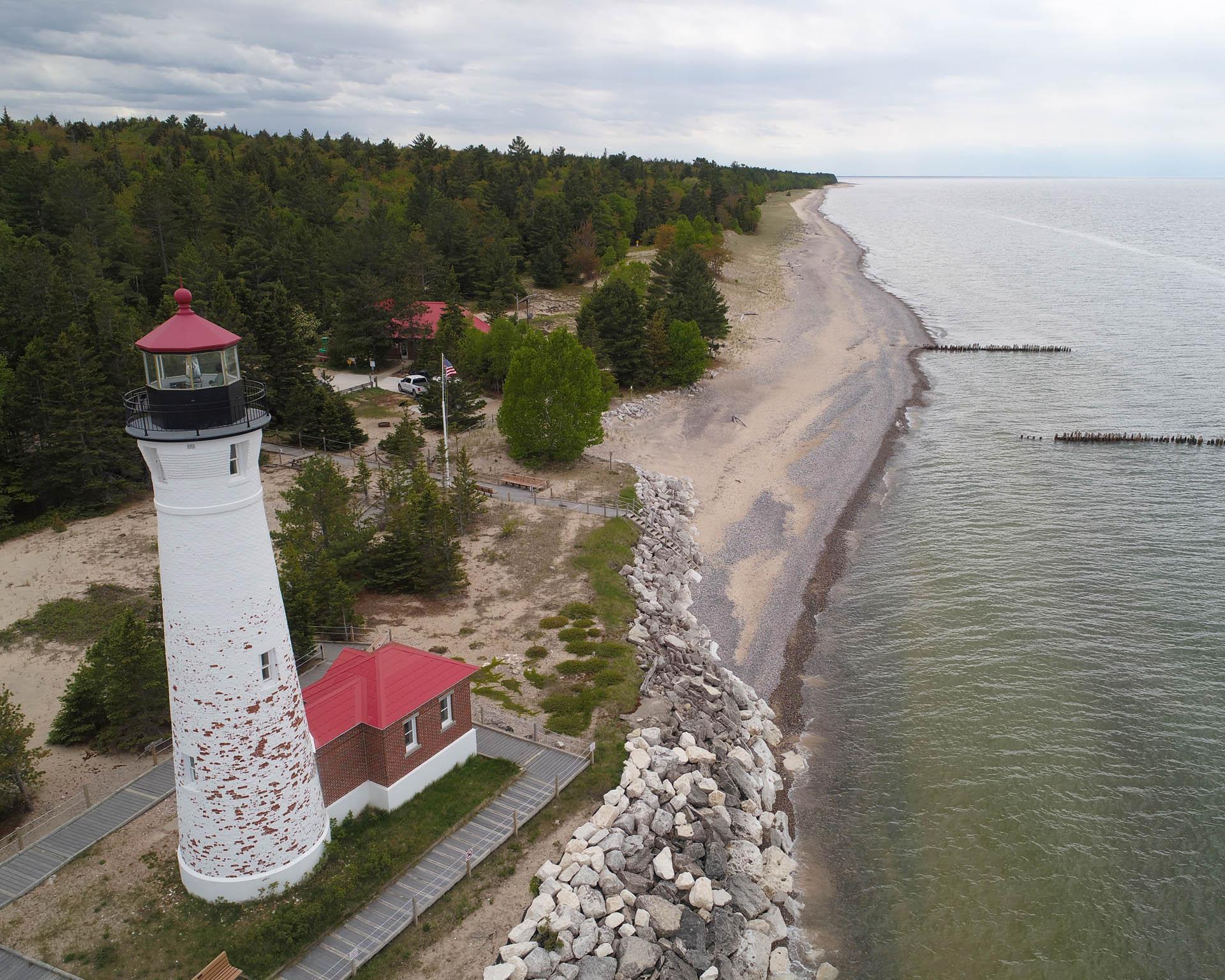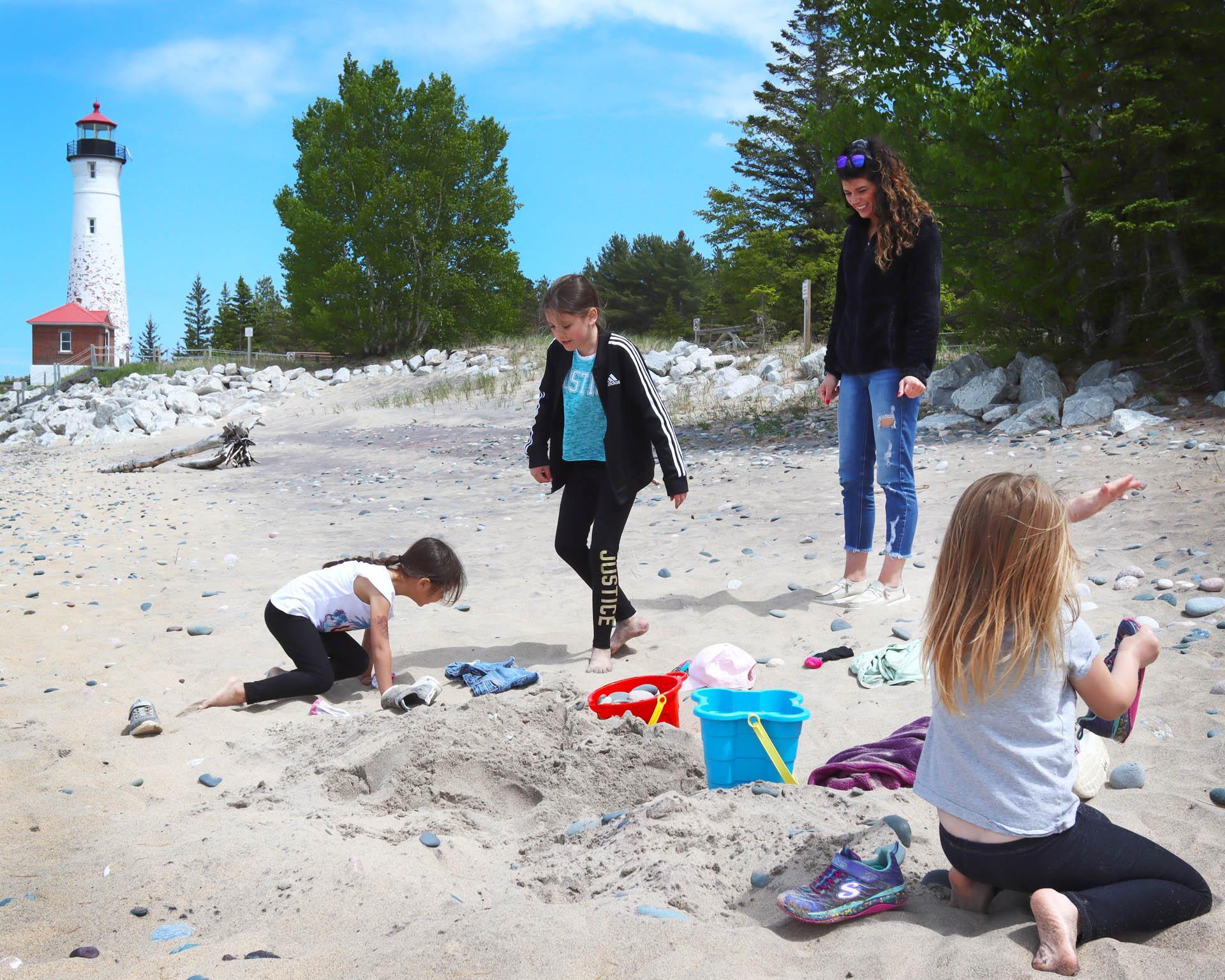

Ready for an unforgettable adventure? Tahquamenon Country offers one of the best year-round treks in the Upper Peninsula.
Crisp Point Lighthouse is a very remote beacon in the U.P. It stands tall on the rugged shore of Lake Superior between Whitefish Point to the east and Grand Marais to the west. For over a century, it’s defied Lake Superior’s powerful gales, bashing waves and blinding blizzards.
Only 40 miles north of Newberry or Paradise, Crisp Point on a map appears to be an easy 45-minute drive — it is not. Expect this trip to take twice that amount of travel time. You need an all-wheel drive (AWD) vehicle and steely nerves to make it here — but oh, the adventure is worth it!
Lighthouse History | How to Get Here | Travel Tips | Hours & Fees | Things to Do | Where to Stay Nearby | Stories from the Past
The Crisp Point Life-Saving Station #10 and keeper’s quarters was built in 1875 and put into service in 1876. It was re-named after one of the light-station keepers, Christopher Crisp, who was also an iron-willed boatman.
In 1896, the government drew plans to build a lighthouse at the life-saving station. The construction and budget were approved in 1902 and the 58-foot tall tower and its attached service building became operational on May 5, 1904. For nearly three decades, Crisp Point guided ships and sailors to safety. Learn more about its incredible story and the people who prevented it from crumbling into the lake. Deb Singleton also shares reflections about her grandfather, Crisp Point’s last lighthouse keeper.
1944 County Road 412 | Newberry, MI 49868 | Visitor Center: 906-658-3600 | Website
There are three modes of transportation to reach Crisp Point Lighthouse: an AWD vehicle, ORV/ATV or when snow is on the ground, a snowmobile.
If you plan to ride an ATV or ORV in the Crisp Point Lighthouse area, review the Michigan DNR rules, regulations and what licenses and permits you need. Use these maps as your guides:
The quickest way to get to Crisp Point Lighthouse is to trailer your sled to Little Lake Harbor on Luce County Road 500.
Or pick up Snowmobile Trail 8 in Paradise. It runs west until you turn left to follow County Road 412 to the lighthouse.
When you enter the service building attached to the lighthouse, view the maritime artifacts. Then climb the 62 metal steps to the top of the tower for an incredible, 360-degree view of Lake Superior, miles of stone-covered beaches and the surrounding primeval forest. Bring binoculars, this is a fantastic place to watch for international and Great Lakes freighters. Then pause to listen to the wind, waves and shore birds. These are sounds heard by lighthouse keepers, sailors and the Ojibwa for centuries … and now you.
In 2012, the Crisp Point Light Historical Society received a permit from the U.S. Coast Guard to install a 300 mm lens in the lantern room. The tower now actively serves as a private aid to navigation from May 1 to November 1 each year.

Lake Superior can be chilly, even on a hot summer’s day. But go into the clear, freshwater. Sit on the benches or bring a blanket or chair onto the beach with sand toys or a good book. Although the beach has eroded over the centuries, you can gather colorful rocks, fossils and, if lucky, the unique-to-Michigan yooperlite stones that glow under a black light.
There is a paved, 0.5-mile out-and-back walking trail that you can easily complete in less than 10 minutes. Or hike, or in winter snowshoe, for an hour along the tawny-brown sand. Along the way watch for eagles, gulls, killdeer and wildflowers.
The Visitor Center houses a gift shop with a variety of lighthouse puzzles, books, toys, snacks and drinks and collectibles. A portion of your purchases helps to support lighthouse upkeep, erosion control and operations. The Visitor Center is closed in the winter.
This is one of a few Great Lakes lighthouses that welcome volunteer lighthouse keepers and assistants. Volunteers stay in their campers or tents in this “Leave No Trace” location without refrigeration or camping amenities other than toilets. If you sign up, bring an electrical power supply, including a generator, drinking water, food, heat, refrigeration and the supplies you need to sustain your stay. Learn more about the lightkeepers program.
The Crisp Point Lighthouse is a day trip from lodgings in Newberry. Book your stay to get the amenities, rates and quick access to some of the most popular U.P. attractions and outdoor activities in all four seasons.
Deb Singleton, manager of the Pleasant Moose Lodge in Newberry, has a special place in her heart for Crisp Point Lighthouse. Her grandfather, Joseph Noah Singleton was the Lake Superior beacon’s last active lighthouse keeper. Joe joined the United States Lighthouse Service on Oct. 22, 1909, and began his 30-year career from First Assistant to Captain and then Keeper at Charity Island, Twin Harbors and Crisp Point.
Lighthouse keeping was in Joe’s blood. His father and grandfather were keepers dating back to Ireland. It was a solitary life at Crisp Point for him, his wife Martha Elizabeth and their four sons Roy, Thomas, John and Charles. They lived in the two-story, two-family house next to the lighthouse from 1923 to 1939.
To help feed his family, Joe and his son Tom built a boat that Joe, his four boys and even Martha would take out on Lake Superior to catch fish for their meals. Martha, however, was the one who took the top prize in the 1939 fishing contest when she reeled in a 31-pound trout while trolling six miles off the lighthouse. They would drink and cook with canned milk, grew vegetables and Joe and the boys hunted deer in the surrounding forest to enjoy a rare meal with meat. At night, they would fall asleep listening to the howling wolves.
But Martha wouldn’t let this rugged life stop her from teaching her family proper etiquette. She would insist that Joe and the boys clean up and come dressed for dinner, covering the table with a white linen cloth and serving the food on nice dishes. Nor would she allow loneliness to dampen her spirits. She would plan picnics with friends on the beach or go out with them for boat rides on the big lake.
Deb said her uncles and father passed down stories of finding skeletons of shipwrecked sailors along the beach. Or the time the “Lighthouse Kids” and the Nolan Boys found a birch bark coffin on the shore. Inside was a Native American woman’s skeleton wearing hand-hammered bracelets and a silver cross necklace. They called her an “Indian Princess” and properly buried her and the lost-at-sea sailors in the cemetery that has since washed away from erosion.
Deb shared many more stories of her grandfather watching helplessly from the lighthouse as a steamer sank in gale winds on November 5, 1925. Or of her uncles’ near-death moments while fishing on the merciless freshwater sea. There were also stories of the Singletons going by dog sled to get supplies in Newberry, only to spend the night burrowed into a snowdrift until a blinding blizzard stopped swirling and wailing around them. These are stories you can think about as you twist and turn your way to Crisp Point Lighthouse. Your journey won’t seem as gnarly.